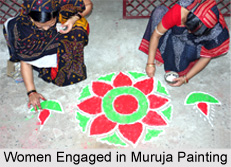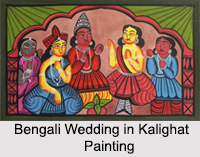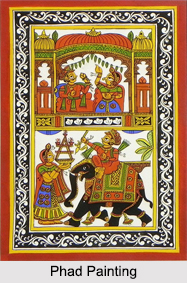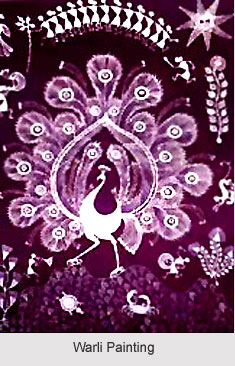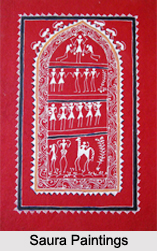 Saura paintings are found in the southern Odisha districts of Rayagada, Ganjam, Gajapati and Koraput. They were first studied by the famous anthropologist, Verrier Elwin. These paintings can be defined as wall mural paintings or tribal art of Orissa. These paintings are associated with the Saura tribes. They are the tribes of the Indian state of Odisha. These paintings are also known as ikons or ekons. They have also been mentioned as Savaras in Mahabharata and Ramayana. They are dedicated to Idital (also edital), which is the main deity of the Sauras. These paintings are known to captivate attention for their elegance, charm, iconography, aesthetic and ritualistic associations. These paintings represent traditional wisdom, knowledge and folklore. These paintings are also identified as visually similar to warli paintings. Religiously and ritualistically, these paintings are important to the Sauras.
Saura paintings are found in the southern Odisha districts of Rayagada, Ganjam, Gajapati and Koraput. They were first studied by the famous anthropologist, Verrier Elwin. These paintings can be defined as wall mural paintings or tribal art of Orissa. These paintings are associated with the Saura tribes. They are the tribes of the Indian state of Odisha. These paintings are also known as ikons or ekons. They have also been mentioned as Savaras in Mahabharata and Ramayana. They are dedicated to Idital (also edital), which is the main deity of the Sauras. These paintings are known to captivate attention for their elegance, charm, iconography, aesthetic and ritualistic associations. These paintings represent traditional wisdom, knowledge and folklore. These paintings are also identified as visually similar to warli paintings. Religiously and ritualistically, these paintings are important to the Sauras.
Sauras Tribes
Sauras Tribes are known to be one of the most ancient tribes in India. These tribes are mentioned in the Hindu epics of Ramayana and Mahabharata. Savari and Jara are considered to be the members of this tribe. The former is known to be Rama"s devotee in the Ramayana, whereas the latter is known to be the hunter who mortally wounded Krishna with an arrow. In the form of a wooden log, Jara"s body is believed to have been flowed into the sea near Puri. It was this wooden log from which the idol of Jagannath at Puri is believed to have been sculpted.
Painters of Saura Paintings
The Kudangs are credited with the creation of Saura Paintings. They are the priestly class among the sauras. This is because they had the expertise to explain the symbolic meaning of the images contained therein to the villagers. Thus, the saura paintings also became a part of the aural tradition of the Sauras that linked them to their traditions and customs. Today, the Kudangs have been replaced by artists and paintings are often executed in non-traditional locales.
Significance of Saura Paintings
The saura paintings were generally painted to appease the Gods and ancestors. They were originally painted on the walls of the Saura`s adobe huts. Also, these paintings are an integral part of the religious ceremonies of the Saura tribes. It is during special religious and cultural occasions such as child-birth, harvest, marriage and the construction of a new house that these paintings are worshipped. It is important to note that these paintings are not commissioned frequently and an existing one can be regularly used for everyday rituals. However, the construction of a new house makes the commissioning of an ekon imperative. In this regard, these paintings are painted in a dark corner inside the home. When they are being created, a specific set of prayers are recited, simultaneously.
They are today increasingly used to decorate items like T-shirts, greeting cards, stationary and items of clothing. They are also known to have been popularized as a means for skill and job creation. Their increasing popularity can be attributed to their diversity, detail and unique style. They have an in-vogue-appeal. Both Saura and Warli paintings have picked up details of technique and style from the other, due to two reasons. These two reasons are the influence of markets and increasing awareness about the other"s forms.
Features of Saura Paintings
The subject of a saura painting is tribal folklore. These paintings are also based on cults and myths. These paintings reflect the literature as well as philosophy of the saura tribe. These literature and philosophy become comprehensible only when the priests or the picture men, as they are locally called, interpret them. The minute details of the paintings reflect the day-to-day lives of the Sauras. There is frequent use of motifs like people, horses, elephants, the sun and the moon and the tree of life in these saura paintings. These painting are also characterized by symbolically pregnant icons that mirror the quotidian chores of the Saura. These icons are extensively used to adorn saura paintings. As far as the backdrop of these paintings is concerned, it is made from red or yellow ochre earth. This red or yellow ochre earth is then painted over using brushes. Tender bamboo shoots are used to fashion these brushes. They also use natural dyes and chromes which are derived from ground white stone, hued earth, vermilion and mixtures of tamarind seed, flower and leaf extracts.
Similarities between Saura Paintings and Warli Paintings
Saura paintings are known to resemble Warli Paintings, due to certain reasons. Both the paintings are examples of tribal pictographs that employ stick figures. Both the paintings use clear geometric frames for their construction.
Dissimilarities between Saura Paintings and Warli Paintings
Saura Paintings and Warli Paintings differ in terms of style and treatment of subjects. In Saura paintings, a fish-net approach of painting from the border inwards is used. This approach is not followed in case of Warli paintings. Conjoint triangles are used to depict the human body in case of Warli paintings while in case of Saura paintings the figures are not so sharply carved. Also, the Warli paintings clearly differentiate between male and female icons, while in case of Saura paintings differentiation between male and female icons is not evident.
Related Articles:
Indian Painting
Indian Tribal Paintings
Tribal Paintings in Orissa
Genres of Indian Tribal Paintings
Miniature Paintings in Rajasthan
Famous Indian Paintings

